
The Nokia 7610 is a Symbian OS smartphone introduced at CEBIT on 18 March 2004. It features a 1 megapixel camera with a design similar to 2003's Nokia 7600. It went on sale with a list price of €500 and came with a 64 MB MMC card. It runs on Nokia's Series 60 platform. It was marketed as a stylish and imaging device, and allowed direct Bluetooth photo printing. End-users can also use the 7610 with Nokia Lifeblog. Other pre-installed applications include the Opera Mobile web browser, RealPlayer pand Kodak Photo Sharing.
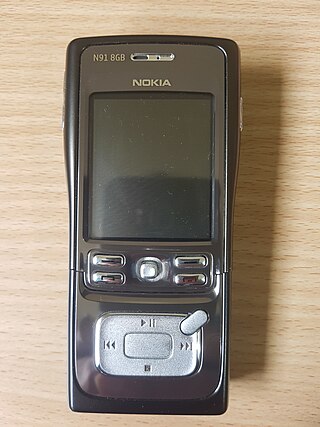
The Nokia N91 is a smartphone produced by Nokia as part of their Nseries line of portable devices. It was announced on April 27, 2005 along with N70 and N90 as the first three Nseries devices. The N91 ran on Symbian-based S60 3rd Edition. It was the first ever phone encompassing a 4 GB internal hard drive, allowing storage for 3,000 songs. The N91 is highly focused on music,. with dedicated music keys on the front which slide down to reveal the keypad. It also featured the industry-standard 3.5 mm headphone jack, and was anticipated as a major challenger to Apple, whose iPod dominated the industry. The design of the N91 is based on stainless steel with a matte finish.
The Nokia 6131/Nokia 6133 is a Nokia clamshell phone introduced by Nokia in February 2006.
The Motorola Q is a Windows Mobile smartphone first announced in the Summer of 2005 as a thin device with similar styling to Motorola's immensely popular RAZR. Motorola in a partnership with Verizon Wireless released the Q on May 31, 2006. A version for Sprint was released early in January 2007 and one for Amp'd Mobile in April 2007.

The Nokia 6120 classic is a mid-range smartphone from Nokia that was announced on 17 April 2007. It runs on Symbian v9.2 with a S60 3rd Edition FP1 user interface.

Nokia 5300 XpressMusic is a slider mobile phone by Nokia, part of the XpressMusic range. It was introduced on 26 September 2006 and released at the end of that year. It runs on Nokia Series 40 3rd Edition FP2.

The Nokia N96 is a discontinued high-end smartphone announced by Nokia on 11 February 2008 at the Mobile World Congress in Barcelona as part of the Nseries line. The N96 runs Symbian OS v9.3. It is compatible with the N-Gage 2.0 gaming platform and has a DVB-H TV tuner and AV output.
The Nokia 3600 slide is a mobile phone by Nokia that was released in August 2008. The phone runs the Series 40 3rd Edition platform. This is classed as the 'low end version' of the Nokia 6600 slide, its major difference being the lack of 3G support.

The Nokia E71 is a smartphone introduced in May 2008 from the Eseries range with a QWERTY keyboard targeting business users worldwide. It runs on Symbian OS v9.2, with a Series 60 3rd Edition, second generation Feature Pack 1. The Nokia E71 succeeded the Nokia E61/61i models, building on the base design and form factor but enhancing on the feature set.

The Nokia 5730 XpressMusic is a smartphone announced on March 11, 2009. Its features include a full backlit slide-out QWERTY keyboard, dedicated camera, volume, gaming and music keys as well as Wi-Fi ( 801.2b/g) connectivity and a basic accelerometer which autorotates the display. It runs on the Nokia's Symbian OS v9.3 S60 mobile phone platform. It is also very similar to the Nokia E75 model, the only difference being that the 5730 is dedicated to play music.
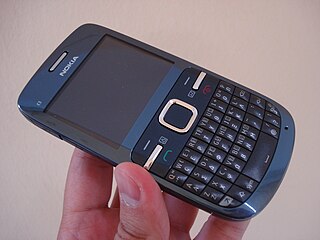
The Nokia C3-00 is a QWERTY keypad feature phone with Nokia Series 40 mobile operating system released under the Cseries line of phones by Nokia. It features a full 4-line QWERTY keyboard, like the earlier Nokia 6800 series. It was advertised as an entry-level messaging and social networking phone, retailing at 90 euros before taxes. It was introduced on April 13, 2010, alongside the Nokia E5 and C6.
The Nokia 7230 is a metallic grilled 3.5G slider phone from Nokia. It was released in 2010.
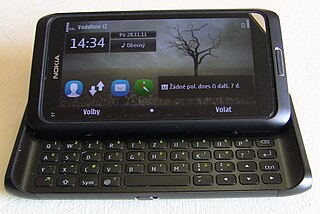
The Nokia E7-00, also known as Nokia E7, is a business-oriented QWERTY smartphone by Nokia from the Nokia Eseries. It was announced at Nokia World in September 2010 together with the Nokia C6-01 and Nokia C7 and started shipping in February 2011. It is the second phone after the Nokia N8 to be running the Symbian^3 operating system.
Nokia's strategic nomenclature can be traced back in 2005 when the Nseries line was launched, offering devices with flagship specifications and premium hardware at various price points. These devices were considered the "bread and butter" of the company and were often positioned to showcase their latest technologies. Thanks to the newfound consumer and enterprise interest in smartphones at the time, the company introduced four additional collections to diversify their product portfolio and meet demands in most market segments. These new phone series were named Eseries, targeting small business and enterprise customers; Xseries, providing consumer-grade multimedia-focused devices; Cseries, which Nokia used to target both the low-end and mid-range market segments; and Tseries, for devices exclusive to the Chinese market.

The Nokia Lumia 820 is a smartphone designed, developed and marketed by Nokia. It is the successor to the Lumia 800 and is one of the first Nokia phones to implement Windows Phone 8 alongside the Nokia Lumia 920. Although sharing a similar appearance with the Lumia 800, the Lumia 820 is a major overhaul over its predecessor, sporting a 4.3 inches (110 mm) diagonal OLED display with scratch resistant glass, though lacking Gorilla Glass protection, 1.5 GHz dual-core processor, and an 8.7-megapixel camera. The phone will come with LTE connectivity and a wireless-charging option. The 820 is the first Nokia Windows Phone OS based smartphone to embed a microSD card slot.

The Samsung Galaxy Star is a low-end smartphone manufactured by Samsung Electronics. It is running on Android 4.1.2(Jelly Bean). It has unofficial Android 4.4, 5.1, 6.0.1 and 7.1 roms. It was announced in April 2013, it was subsequently released in May 2013. It is the cheapest smartphone in the Samsung Galaxy series. Like all other Samsung Galaxy smartphones, the Galaxy Star runs on the Android mobile operating system. The phone is available in 2 versions: a single SIM version (GT-S5280) and a dual SIM version (GT-S5282). The phone competes with other low-cost smartphones such as the smartphones from the Nokia Asha series as well as low-cost smartphones manufactured by Indian manufacturers such as Micromax, Karbonn, Spice Digital, Lava International and Celkon. It is available in certain Asian countries such as India, Pakistan, Sri Lanka, Nepal, Bangladesh, Myanmar, Philippines, Indonesia etc. where low-cost smartphones are very popular as well as in Morocco, Algeria, South Africa, Portugal, France, Germany, Russia and Ukraine. Brazilian version is also released, dubbed GT-S5283B.

The Nokia Lumia 1520 was a flagship Windows Phone phablet smartphone designed and produced by Finnish telecommunications manufacturer Nokia in partnership with American software manufacturer Microsoft. The device was first announced at the Nokia World event on 22 October 2013 in Abu Dhabi, alongside its mid-range phablet stablemate the Nokia Lumia 1320 and Nokia's 10.1 inch Windows RT tablet the Nokia Lumia 2520. Until its discontinuation in the United States on 7 April 2015 the phone served as the flagship device for Nokia's Lumia Series and Microsoft's mobile effort. On 6 October 2015 Microsoft officially announced its flagship phablet successor, the Microsoft Lumia 950 XL, with availability sometime in November 2015.
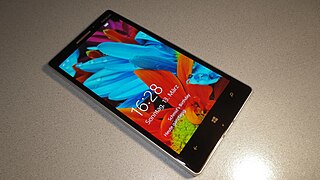
The Nokia Lumia 930 is a high-end smartphone developed by Nokia that shipped with Microsoft's Windows Phone 8.1 operating system. It was announced on April 2, 2014 at Microsoft Build 2014 and was released in April 2014 as Nokia's flagship. It is the last high-end Nokia-branded Lumia device and succeeded by the Microsoft-branded Lumia 950 and its XL equivalent.

Nokia 101 is an ultra-basic dual-SIM mobile phone by Nokia. It is primarily geared for users in developing countries, or for people who need a simple communications device with FM radio and music playback.
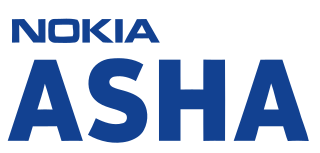
The Nokia Asha 310, also known as the Nokia Asha 3010 or the Nokia ASHA 310 RM-911, was released in March 2013. It is the first in the line of the Asha range of phones to have dual subscriber identity module (SIM) slots and Wi-Fi connectivity. It was a reinvention of the Asha range to remain competitive with new Android devices. It cost $102.00 at its launch date. It has a touchscreen, comes with either a 2 or 4 GB micro SD card, and has 64 MB of RAM, a 2 MP camera and a battery that can last up to 600 hours in standby mode. The phone can play music for up to 54 hours or video for up to 9.5 hours, and has a maximum of 17 hours talk time (2G).















